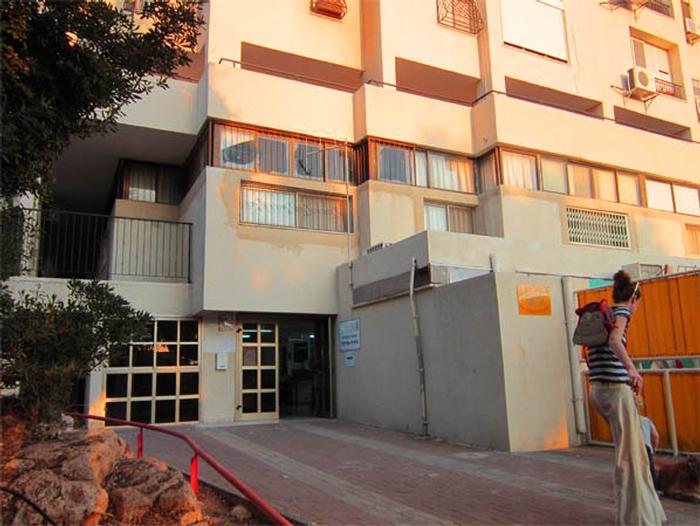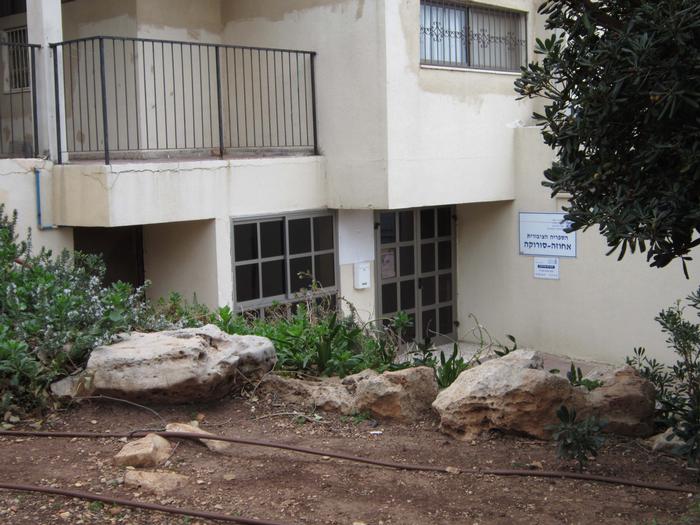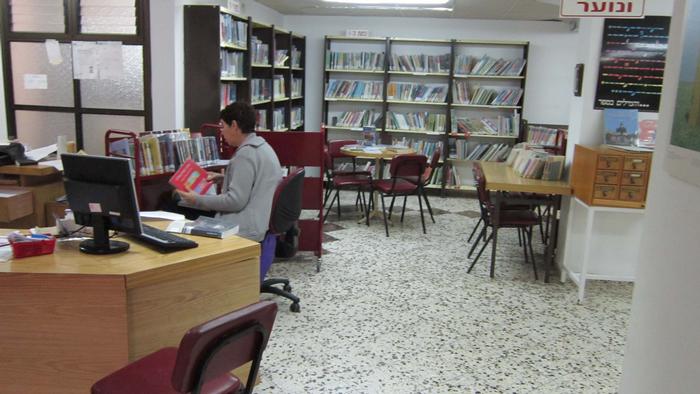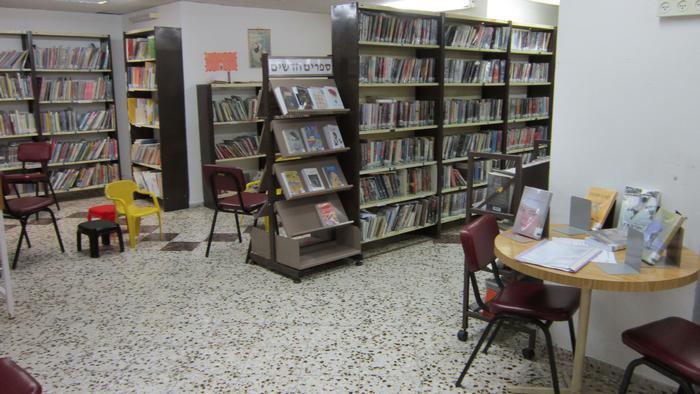[ID:400] Humble and greatIsrael The young man appeared out of nowhere, skipping between patches of the
lamps’ dim light. Equipped with nothing more than flip-flops and a
book, he entered the library briskly. After bowing to the welcoming
librarian, he paced to his favorite book section, pulled out a book
and began reading vigorously under the scarlet twilight sunbeams.
Time was crawling, the place had taken on an “urban –fortress like
character “, the low ceiling embraced the light which permeated
through the “slit like window”, wandering over the ceiling and
changing the sacred atmosphere. Now, the man was mumbling as though he
was a monk, preying and wobbling devotionally.
Even though its small measurements, the library produces a great
experience and ensures a variety of sensations. Admittedly we would
expect such architectural feelings to take place in large scale and
high budget buildings, designed by well-known professionals.
Here we are exposed to the sanctum-sanctorum , the “wet dream” of
modern architecture – low cost with restrained design, yet its
richness has numerous virtues.
It seems that sacred public space sheds its own “architectural
dignity” and humbly absorbs what was first pronounced by the ancient
Greeks - “genius – loci”.
The Greeks, in their sensitive way, were able to feel the vibrating
pulse of a given environment, and excavates the “spirit of the place”
- in Greek “Genius loci”.
The greatest achievement of these “Geniuses” was the development of an
outstanding architectural skill which produces lovely places. The
Greeks’ ancestors could use a wizard- like ability to intercept a dull
deserted hill with nothing more than a wrinkled olive tree and a few
rocks and forge there a wondrous public shrine.
The method of this process developed carefully,
First the Greeks scrutinize the character of the site by exploring
virginal routes toward it and gave specific attention for certain
views.
Afterwards they gently placed an alter on top of the hill in a point
that would reveal the environments best scenes and adequate for the
believers’ assembly. In an unexplained way, a flow of believers
washed the deserted hill almost immediately. Gathered together
densely, worshiping their gods vigorously, their docile silhouettes
were bent in the breezy wind.
Now, we can conclude about a certain issue; The Greek architectural
ancestors had a magnificent virtue,
Their ability to peel the layers of chaos and discover the strata of
holiness. They were delicately exposing the true DNA of a “site” and
made it a “place”- this is what architecture is all about.
Well … thousands of years have passed since the wise Greeks had done
their architectural magic, yet it seems nothing has changed…
In a specific location in Haifa, a northern port city in Israel, the
library enjoys being soaked in the Carmel Mountain’s green slopes.
Through coiled paths, the place is being dimly discovered between the
rustling pine trees that swing and cradle the building gently. The
humid Mediterranean winds teasing the place’s envelope and pat the
place's walls softly.
These walls function as a selective membrane of the urban upheaval,
soothing the unwanted sounds from entering the place in order to
create a specific experience.
Opened to the public only in the afternoon, nearly no sound penetrates
the “educational – fortress” except muffled cheers of kids playing
outside- a pleasant sound in an urban area. The unique voice of
squeaky kids declares that day life proceeds and the vitality of youth
encompass the adjacent environment.
-I do remember the first time I visited the library and was charmed by
its vivid surrounding. This surrounding
has peculiar interaction with the educational public space.
The sacred place, the special library, it is as if it radiates and
creates a certain halo- “public –halo”. that
“halo” is a vast space that embraces the “sanctuary of knowledge” and
is saturated in its influential presence.
We can roughly divide that extraordinary space into three imaginary
rings; each ring has a different relationship with the library’s
functioning. Even though we visited the area quickly, the “halo” was
felt strongly.
The last rays of the sallow sun were retreating feebly as
we slowly headed to the library, thin gravel cracked under our shoes
while low manicured bushes escorted and curved with us.
We lingered on the threshold for a moment; our eyes met a glossy wide
door. The darkened windows deceived us - it seemed as though it was
too quiet to be active.
We declared our coming, protruding the outer shell,
The first ring, the heart of the place, revealed its magnificent
innards, exposing its complete beauty.
Our eyes took a hasty glimpse as they grew accustomed to the
shimmering lights; our ears received thuds of books being fluttered.
Faint chattering of excited People, exchanging reading experience
could be heard in the immediate area, though not a single word could
be understood properly.
Indicated by dense book shelves, dark furniture, shorty columns and of
course walls, each space has a unique character suitable to a certain
population sector. This fact increases the chances of meeting adequate
reading colleagues, with similar book preferences. Several scenes
were happening while we stepped slowly into that cosmic books hall.
A Grandfather fascinates his grandchildren by imitating lord Dracula’s
deep voice, a young boy recumbent on the fluffy carpet, amazed by
"Sherlock Holmes" tales
All those occasions occur frequently, the figures may change ,however
the scene is almost the same.
After the condensed injection of great inner space,
Suddenly ,For some reason we feel seduced by an unconscious feeling
that there is more than this wondrous place.
Our body being shoved by the soul back to the entrance,
Now everything seems logic…
Great architecture does not end in its walls, when one feels the
presence of the building- there it begins.
We scan the area briefly, a playground
and a kinder garden are in a hand reach, apparently we are sunken in a
unique “social- habitat” .
As though to ratify my “social assumption”, Alex, a friend of mine and
a fellow comics books enthusiast, jumps over a few chiseled steps in
my direction.
“Hey is that the last copy?!? He tries to decipher the half hidden
book hooked under my left arm. To be honest he perfectly knew what it
was.
Unfortunately my hesitation exposed the truth…
“A…I think … maybe… you should…” I fail answering him instantly and
stutter an awkward sentence.
“NO YOU CAN NOT!!!” he takes a deep pace, terrorizing my safe holds.
My left leg is completely numb preventing me of escaping in my secret
emergency lane.
But I do not lose my mind, regulating a self controlled duchess
manner- Alex retreats…
After the situation is solved Alex keeps sting my conscious with his
regular complaining hoarse voice, while we clamber to the small
playground.
But I'm not listening to him, as my thoughts wander…have we just left
another halo’s ring?!?
While we were arguing about the comics book, the second ring of the
“public halo” wrapped the embarrassing situation.
That ring expands over the library threshold’s area, consisted of
people who incidentally met each other in recent library visits.
Exactly like me and Alex; we are both comics’ fans and know each other
since he once intercepted a “Spiderman” rare copy in my heavy comics
pile. The major part of these random meetings occurred while
exchanging “shocking-ends recommendations” or other specific feelings
that aroused Goosebumps.
All the involved characters have had in common just a hint of passion
for literature, but from now on… who knows…
Alex is apparently still not satisfied, he clambers the steps wearing
a rigid expression, keeping his bully shoulders parallel to mine, his
eyes still fixed upon my comics book.
In that exact moment, the flourishing kinder garden appears in its
full vitality, successfully easing the uncomfortable situation.
A Woman cradles her baby while scanning her recently loaned book and a
young girl painting a ginger cat, which embellishes a colorful zoology
pamphlet. Simultaneously in some of the playground’s shady corners
,impatient youngsters can be seen reading the first pages of the third
part of a trilogy. All these activities can be done alone - if one
wants to achieve a private situation, or in a group for a more
social mixed activity.
In my opinion, the co-existence between the people, the tolerance for
the others needs in that marvelous place, this, this is what makes
that garden desired by the people.
Suddenly a bunch of kids bustling around the water tap increases the
levels of noise in the atmosphere, though no one seems to be upset
about the sudden intrusion.
The kids are drifting to a street near the main road of the
neighborhood. Their youth has some unique grace – so naive but still
carrying a certain level of maturity.
As my friend and I leave the kindergarten and its calm atmosphere, a
staggering old man with a cylinder hat bids us farewell.
We turn our heads back to the immediate environment of the library.
From this point of view, everything is apparently simple and
vulnerable.
The “educational castle” emits pinches of people from its guts. From
the guts-the first “public halo” ring, piled with heavy books ,the
people pass through to a second ring - the threshold area between the
the emerald green vegetation.
Some of their faces seem to be clear, as they stride in my direction
revealing their familiar features. Alex and I decide to accompany
these people in order to explore the place from their point of view.
They pass by the swarming kindergarten, cross the serene playground,
just a fraction of a second before they ascend to the main road.
Its seems as though something has been dissipated…
That is the third ring of the “public halo”- stretched from the
adjacent facilities to the cobblestone of the main road.
After arriving at the main road, the library loosens its tight grip
over its immediate environment - the peaceful mood evolves to a busy
frantic street.
We take one last glance over what we left behind; there is no doubt
it’s a seamless ,well defined area.
Bus number 29 groans as it comes to a halt, carrying me and Alex to
the city center. Looking back through the thin mist that was pressing
itself against the bus window, I gaze over two high buildings. One of
Those buildings occupies the library.
My mind was busy thinking, thinking about the sanctuary of knowledge.
Why is it so successful and draws attention although it’s modest
attitude?
It turns out that in the 70's, a conductor called “Bleicher group”
built two similar dwelling buildings in the young neighborhood “Ahuzat
Samuel”.
Those buildings are the highest buildings in the entire neighborhood
and have a prominent appearance in Haifa’s curvy skyline. Following
that construction, a diverse concentration of hundreds of dwellers was
created due to the new buildings and an adequate public space was
essential.
The amazing thing in the response for that social need is the
precision and the gentleness in the way it was entwined.
Jonathan, a veteran resident states as we interview him: “I think that
in the beginning, when the buildings were almost fully occupied, the
library wasn’t active at all. Maybe because the municipality didn’t
acknowledge the importance of such educational public spaces.
Then, after a few months, a rumor was spread about a new attraction in
the building . I remember the first time I visited the library, when
actually I was not a books fan. My brother asked me to bring his book
“Dune” back to the library. Though I was reluctant to do this “older
brother favor”, I do remember the specific moment that I stepped into
the library wearing a pair of embarrassing shorts and I noticed a
bunch of kids exploring the science – fiction section.
Since that day, I haven’t missed an opportunity for visiting that
“books stronghold” and meeting these kids." Jonathan gives a great
sigh and continues;” I can compare this situation to a complex puzzle-
game; When we assemble a puzzle, first we turn to the major parts of
it and try to figure out the clear picture it represents .In the
second stage we must fill these unfinished patches that we left
uncompleted in order to reveal the picture’s details. The last stage
and the most exciting one is putting the last piece of the puzzle.
Suddenly the delightful scene is exposed, exactly like the library and
its lovely environment.
In the beginning the neighborhoods first buildings were established
and then the two high dwelling buildings were built. Eventually the
last piece – a small delicate public library was embedded precisely in
the lowest floor of the massive building and the puzzle was complete.
Jonathan clears his throat and keeps talking; apparently, the
neighborhood had everything - young couples with kids who wanted to
settle down in a serene neighborhood and worked around the clock to
achieve it. Don’t understand me wrong- facilities such as playgrounds
were located in the neighborhood’s different zones, before they opened
the library. It seems as though in a real successful public space, we
need to do more- much more then creating a certain facility, because
that just won’t do the job…”
Jonathan finishes the interview, gulping its coffee ; and leaves the
place.
New conclusions arouse in my mind as I conclude this long journey of
decoding the library’s success.
When we search for that “special ingredient” which turns adequate
public spaces into good ones, the specific location and design is
probably the secret. The need for glorifying the library's appearance
or its designer's reputation is simply not there.
One would point out the unique location, mostly by the readers’ flow
emitted from its immanent sacred spaces and not by
the small sign placed near its entrance.
All the virtues that reside in the library, contribute for a certain
notion;
The library addresses the idea that a human being is unique and should
be treated as such. The belief that the more specific a design idea
is, the greater its appeal is likely to be - that belief, is oozing
from the walls .
The experience of going to the library is similar to an invitation to
a mysterious sect assembly, an assembly that worships knowledge,
culture and leisure.
If you would like to contact this author, please send a request to info@berkeleyprize.org. |




